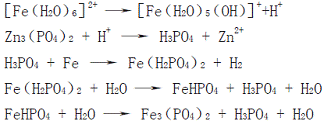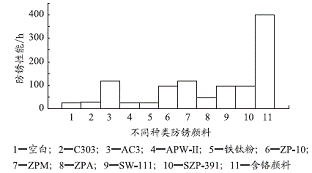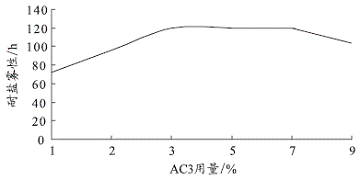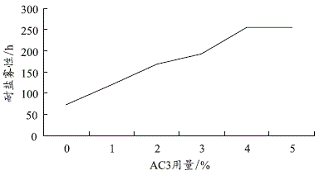Zhuang Zhenyu Hu Zhongzhu Baoying Zhang Hanqing Zhu Ke
(CNOOC Changzhou Coating Chemical Research Institute, 213016)
Abstract: An acrylic amino resin with an internal cross-linking structure is used as a basic film-forming material, mainly based on environmentally friendly anti-rust pigments, with a small amount of chromium pigments, to develop a water-based paint. The coating has excellent corrosion resistance, weather resistance, gloss retention and color retention, and has the effect of unifying the bottom surface.
Key words: bottom-in-one coating; anti-rust pigment; water-based coating
0 Preface
Water-based coatings have become the main substitute for traditional solvent-based coatings due to their non-toxic, non-odor, non-flammable and easy to clean properties. At present, metal parts, such as lamps, toys, motorcycle frames, compressors, automobile chassis, etc., in order to achieve corrosion resistance, aging resistance and good decorative effects, generally need to be sprayed in two steps of primer and topcoat. Cumbersome construction and high production cost. Cathodic electrophoretic coatings and waterborne epoxy-amine curing systems, etc. use epoxy resin (mostly bisphenol A epoxy resin) as the main film-forming material, which has high adhesion and excellent corrosion resistance, but the outdoor of epoxy resin It has poor weather resistance, easy powdering, and loss of gloss. The fullness of the coating film is not high. It is not suitable for high-quality outdoor paint and high decorative paint. It is often used as a primer. Water-based acrylate resin has been widely used in various coatings due to its excellent weather resistance, gloss retention and color retention, and it can play a very good decorative performance, but its corrosion resistance is slightly worse, and it is often used as a top coat. Therefore, the bottom-in-one coating with excellent corrosion resistance and decorative properties has very good application prospects. As we all know, the one-sided coating requires excellent anti-corrosion performance, so the requirements for anti-rust pigments are high. Traditional anti-rust pigments often contain elements such as chromium and lead, such as chromates of red lead, lead powder, and zinc. Although they have excellent anti-corrosion properties, they pollute the environment and endanger health. In recent years, the European Union has successively increased restrictions on harmful substances in electrical products, and the limits on metal elements such as lead, mercury, cadmium, and hexavalent chromium have become increasingly stringent. Therefore, the selection of environmentally friendly, non-toxic and anti-rust pigments that comply with the RoHS Directive (Restriction on the Use of Certain Hazardous Substances in Electrical and Electronic Equipment) for water-based undercoat coatings has become an urgent task. In this paper, a baking type waterborne bottom-in-one coating is developed, which uses an acrylic resin with an internal cross-linking structure as the basic film-forming material, and is equipped with environmentally friendly composite anti-rust pigments. The coating has excellent corrosion resistance (salt spray resistance up to 240h), weather resistance, gloss and color retention, and has the effect of unifying the bottom surface. It can be applied by dip coating, spray coating and roller coating, and is non-flammable. , Non-explosive, low toxicity, low pollution, low cost and convenient construction.
1 Experimental part
1.1 Raw materials
Antirust pigments: zinc phosphate (ZP-10), zinc phosphomolybdate (ZPM), zinc aluminum phosphate (ZPA), ion exchange type antirust pigments (AC3, C303), Grace; strontium phosphate silicate (SW-111) ), A mixture of strontium phosphosilicate and zinc phosphosilicate (SZP-391), HALOX Pigment Company of America; aluminum tripolyphosphate (APW-â…¡), Guangxi Xinjing Technology Co., Ltd .; chromium-containing pigment; iron titanium powder, Wanda Technology company. Water-based acrylic resin: self-made; amino resin: cyanate chemical; leveling agent, defoamer: BYK company; barium sulfate: German Shaliben (Sachibin); ultrafine talc: Guilin Longsheng Risheng ultrafine Talc Powder Co., Ltd .; Carbon Black: Degussa Corporation.
1.2 Instruments
Precision booster electric mixer; electronic balance; electric blast drying oven; salt spray box; gloss meter WGG60; adhesion meter; thickness gauge.
1.3 Coating preparation
Add water-based acrylic resin and neutralizer according to the coating formula shown in Table 1 and mix well. Stir for 10 minutes with a high-speed disperser; add deionized water and defoamer, stir and disperse evenly, then add anti-rust pigment and other pigments and fillers Stir evenly; grind the above slurry through a sand mill to a fineness below 15μm, add curing agent and leveling agent, mix evenly at low speed, adjust the viscosity with deionized water, and filter with a 200 mesh filter.
Table 1 Basic formula of paint
1.4 Preparation of test plate
(1) Substrate: 3mm thick cold-rolled carbon steel plate, size 120mm × 60mm, the surface is degreased and mechanically polished;
(2) Plate-making: spray the paint on the steel plate, dry it for 20 minutes and place it in an oven, bake at a constant temperature of (140 ± 2) ℃ for 0.5h, the thickness of the coating film is about 18μm, and the edges are sealed with tape;
(3) Salt spray test: two cross lines with a width of 0.05mm and a length of 50mm are drawn in the middle of the sample plate and placed in a salt spray box. According to GB / T1771-1991 salt spray test standard, 5% NaCl neutral solution is used. Judgment criteria: Figures 1 and 2 are etched bilaterally by 3mm, and Figures 3 and Table 2 are etched bilaterally by 2mm.
2 Results and discussion
2.1 The mechanism of action of anti-rust pigments
According to its mechanism of action, anti-rust pigments can be divided into physical anti-rust pigments and chemical anti-rust pigments, and comprehensive anti-rust pigments with both physical and chemical mechanisms. Physical anti-rust pigments are chemically stable. Commonly used non-toxic anti-rust pigments include iron oxide red, mica iron oxide, mica powder, glass flakes, aluminum powder, etc. Based on its own chemical activity, chemical anti-rust pigments react with metal ions on the metal surface to form a dense passivation film to inhibit the corrosion process during metal corrosion, or to protect the metal by sacrificing the anode according to electrochemical principles the goal of. Chemical anti-rust pigments can also chemically react with certain components in paints to produce compounds with stable performance and good water resistance. Commonly used anti-corrosion pigments include: phosphate-based, modified phosphate-based, and ion-exchange pigments. Comprehensive anti-rust pigments have both physical anti-rust and chemical anti-rust mechanisms. Commonly used non-toxic anti-rust pigments are: flake zinc powder, flake zinc aluminum alloy, composite iron titanium powder, etc. This paper mainly uses chemical anti-rust pigments and comprehensive anti-rust pigment iron titanium powder for experiments. Chromium-containing pigments have good anti-corrosion properties. When water passes through the coating film, chromate ions will be dissolved out. Its strong oxidation effect causes a passive film to be formed on the metal surface, which is difficult to be destroyed by Cl- penetration. Well, there is little loss of adhesion. Ion exchange pigments (such as AC3 and C303 produced by Grace Company are calcium ion exchanged silicas). The anticorrosive effect is through the exchange of corrosive ions containing the antirust pigment with the calcium ions of the pigment. The calcium released is The interface between the coating and the metal is deposited and shielded. The reaction process is as follows:

Phosphate is one of the substitutes for lead and chromium pigments. It is widely used in coatings as a chemical anti-rust pigment. It is currently the largest and most widely used non-toxic anti-rust pigment. The action mechanism of phosphate-based anti-rust pigments is complex. The main anti-rust mechanism of zinc orthophosphate is:

This type of anti-rust pigment can chemically combine with hydroxyl groups, carboxyl groups, etc. in the paint, and can also form Fe [Zn3 (PO4)] on the metal surface to form a polymer complex of pigment-paint-substrate to prevent rust. Formation and erosion. The anti-corrosion performance of zinc phosphate anti-rust pigments in water-based coatings is general, and changing the phosphate of a single metal to a mixed phosphate of several metals greatly improves its anti-corrosion effect. Modification methods of zinc phosphate are: organic modification, zinc molybdate modification, iron phosphate modification, aluminum phosphate modification, calcium strontium aluminum modification, etc. Zinc phosphomolybdate and aluminum tripolyphosphate are newly developed anti-rust pigments in recent years. For example, PetrKalenda et al. [1] modified zinc phosphate, and found that zinc phosphomolybdate has better anti-rust effect; Zhang Li et al. [2 -4] The anti-corrosion mechanism and performance of modified aluminum tripolyphosphate in water-based coatings were studied in depth, and aluminum tripolyphosphate can be used to replace chromium-containing pigments. The composite iron-titanium powder is composed of ultrafine composite powder coated with high temperature on the surface and a small amount of metal salts. There are various anti-rust mechanisms, such as chemical anti-rust and nano-physical anti-rust.
2.2 Selection of film-forming materials
In this experiment, an acrylic amino resin with an internal cross-linking structure is used as the film-forming material, which contains hydroxyl and carboxyl groups, has good adhesion to the substrate, has excellent alkali resistance, and has a dense film formation, which can reduce the penetration of water, oxygen, and ions. .
2.3 The influence of different kinds of anti-rust pigments on anti-corrosion performance
According to the coating formula shown in Table 1, different types of anti-rust pigments are used respectively. The amount of anti-rust pigments added is 5% (total mass ratio), the same PVC (pigment volume concentration) is controlled to 0.6 and the amount of anti-rust pigments added , Prepared according to the 1.4 method, the salt spray test results of the test board are shown in Figure 1.

Figure 1 Comparison of salt spray resistance of different types of anti-rust pigments
It can be seen from Figure 1 that the chrome-containing pigment has the best salt spray resistance. Followed by AC3, ZPM, SW-111, SZP-391, ZP-10, blank sample, C303, APW-â…¡, iron titanium powder in this system has poor salt spray resistance.
2.4 Effect of anti-rust pigment dosage on salt spray resistance
The effect of the amount of AC3 on the salt spray resistance of the coating is shown in Figure 2.

Figure 2 Effect of the amount of anti-rust pigment AC3 on salt spray resistance
As shown in Figure 2: When the amount of anti-rust pigment AC3 increases from 1% to 5%, the salt fog resistance increases; when the amount continues to increase to 7%, the salt fog resistance does not change much; when the amount reaches 8% , Salt spray resistance decreased instead. In general, with the increase of the amount of anti-rust pigments, the anti-rust property increases, but if the amount of oil absorption of the anti-rust pigments is large, it will affect the gloss and compactness of the coating film. On the other hand, if the water solubility of the rust preventive pigment is large and the ions are eluted too quickly, the coating film is likely to cause blistering due to osmotic pressure. The amount of anti-rust pigment should be 5%.
2.5 Effect of anti-rust pigment and chromium-containing pigment mixed on salt spray resistance After adding a very small amount of chromium-containing pigment, examine the effect of AC3 dosage on salt spray resistance. The results are shown in Figure 3.

Figure 3 After adding a very small amount of chromium-containing pigment, the effect of the amount of anti-rust pigment AC3 on salt spray resistance
As shown in Figure 3: A small amount of chromium-containing pigment is mixed with AC3. When the amount of AC3 is greater than 3%, the salt spray resistance of the coating film can be significantly improved. This is because the chromium-containing pigment dissolves chromate ions in the water and the iron ions generated by the anode. A layer of metal oxide hydrate is formed on the surface of the steel to passivate the metal surface, thereby preventing the corrosion process from proceeding. However, SiO2 in AC3 reacts with the OH- of the cathode, and eventually a CaSiO3 deposit can be formed, which blocks the redox reaction of the cathode.
2.6 The effect of pigment volume concentration on anti-rust performance
Pigment volume concentration (PVC) has a greater impact on rust resistance. With the increase of PVC, the adhesion of the coating film increases, and the water vapor transmission rate decreases; if PVC exceeds CPVC (Critical Pigment Volume Concentration), the permeability, blistering, and rust resistance of the coating film change suddenly. In addition to anti-rust pigments, some fillers are often added to anti-corrosion coatings, such as talc, barium sulfate, kaolin, etc., to adjust the pigment volume concentration in the coating film and reduce the shrinkage of the coating film. Taking Table 1 as the basic coating formula, using a small amount of chromium-containing pigment and 4% AC3 as anti-rust pigment, and adjusting PVC with filler, the results are shown in Table 2.
Table 2 The effect of pigment volume concentration on coating performance

In this paper, the water-based bottom-in-one coating has a thin coating. The addition of filler will increase the roughness of the coating film and affect the compactness and gloss of the coating film. Therefore, PVC / CPVC≤0.6 is selected, which has good comprehensive performance.
3 Conclusion
In this experiment, the type and amount of anti-corrosion pigments in the water-based all-in-one coating were selected and compared. It was found that a small amount of chromium-containing pigments combined with environmentally friendly anti-rust pigments can exert the synergistic effect of the two and significantly improve the coating's shielding. The role and adhesion of the coating to the substrate, to prevent the coating and substrate from peeling and blistering, and have a good effect against scratch corrosion.
Here you can find the related products in Plastic Bathroom Products. If you want to know more about Plastic Bathroom Products, such as Plastic Bathroom Organizer and other Household Plastic Products, please click the product details to view parameters, models, pictures, prices and other information.
Whatever you are a group or individual, we will do our best to provide you with accurate and comprehensive message about Plastic Bathroom Products!
Plastic Bathroom Products
Plastic Bathroom Products,Eco Toothbrush Cup,Bamboo Toothbrush Cup,Oval Travel Cup
Fulike Houseware&Gifts Co.,Ltd. , https://www.cnfulike.com